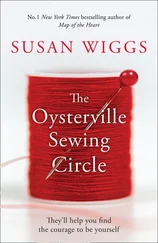He was dog tired, but he put on a smile because, in spite of everything, he shared her enthusiasm.
“I thought about going into the service and learning to fly,” she said, her eyes shining. “Couldn’t make the commitment, though.”
“Lots of people can’t.” He said it without condemnation or pride. It was a plain fact. The U.S. Navy demanded half of your life. It was as simple as that. He’d been in the Navy since his eighteenth birthday. And of his twenty-six years of service, he’d been at sea for half of them. That kind of commitment had its rewards, but it also carried a price. He was finally figuring that out.
As he went to the door, the Inbox on his computer screen blinked, but he didn’t check to see what had come in. If it was personal, he didn’t want a reporter reading over his shoulder.
He led her single file down a narrow passageway tiled in blue, narrating their journey and cautioning her to avoid slamming her shins on the “knee knockers,” structural members at the bottom of each hatch. Lining the P-way were dozens of red cabinets containing fire-control gear and protective clothing. The least little spark could take out half the ship if it happened to ignite in the wrong place.
Steve spoke over his shoulder, but he wasn’t sure how much she was taking in. The constant din of flight ops intruded—roaring engines, the hiss and grind of the power plant and arresting gear, the whistle and screech of aircraft slamming on deck—drowning out normal conversation. In the enlisted men’s mess, they created a small stir. Sailors enjoying MIDRATS—rations for personnel on night duty—stopped what they were doing the minute they saw Francine Atwater. Their jaws dropped as though unhinged. Even the female sailors stared, not with the raw yearning of the males but with wistfulness, and perhaps a flicker of disdain. In the service of their country, they had learned to do without makeup, without hair spray, without vanity.
As they climbed an open steel ladder, Atwater took it in stride, but she was probably wishing she’d worn pants and thick-soled boots. They crossed the hangar bay, where aircraft waited with wings folded like origami cranes.
In the passageway under flight-deck control, the roar of aircraft pounding the steel deck was louder still. “We need to gear up,” Steve said, handing her a flight suit and boots.
“I’ve been briefed on safety procedures.” She sat down and slipped off her civilian shoes, flashing a slim foot encased in a nylon stocking. “Hours and hours of briefing.”
“The Navy loves to brief people,” he admitted, hearing echoes of the endless droning of Navy gouge he’d endured over the years, litanies of instruction and advisories. “In this case, I hope you listened,” he added. Then, assuming she hadn’t, he reiterated the list of hazards on the flight deck. A sailor could be sucked into an engine intake. Exhaust from a jet engine had the power to blast a person across the deck, or even overboard. He’d seen large men bouncing like basketballs all the way to the deck edge. Or an arresting wire might snap as a tail hook grabbed it, whipping with enough force to sever a person’s legs. Taxiing planes, scurrying yellow tractors, breaking launch bars—all were hazards waiting to happen.
His hand wandered to his throat in a habitual gesture, seeking his St. Christopher medal. Then he remembered that he’d lost it, the good-luck charm he’d had since his first deployment. He never went to sea without it. Ah, hell. At least he wasn’t flying.
He distracted himself by perusing the bulletin board of one of the squadrons. The postings included items for sale or trade, a movie schedule and an invitation to the upcoming Steel Beach picnic, during which a dozen or so garage bands would perform. Personnel on board were desperate to create a normal existence in a highly abnormal situation.
It didn’t always work, Steve thought.
After she finished gearing up for flight ops, Francine Atwater looked totally different. Steel-toed boots, a shiny gray-green jumpsuit and a white visitor’s jersey hid all of her charms except those big brown eyes.
Feeling a bit like an airline flight attendant, he showed her how to operate her float coat. The vest was equipped with a beacon light, a packet of chemical dye to mark the water if she found herself in the drink, a flare, a whistle. “This is your MOBI,” he said. It was a transmitter the size of a cell phone, with a whip antenna connected to a small box.
“Let me guess. Man Overboard…Indicator.”
“You did your homework.”
“I told you, I was briefed. But you’re forgetting something,” she said.
“What’s that?”
“I don’t intend to go for a midnight swim.”
“Then we’re on the same page.” He slipped the device into the dye pouch of her float coat and closed the Velcro fastening. “But just in case, the transmitter has its own unique identification. That way, the bridge will know identity and location immediately.”
“So this one has my name on it?”
“Just the number of the float coat. You want me to show you how to fasten everything?”
“I’ve got it,” she said.
He showed her a status board outlining the night’s exercises. The list indicated who was taking off, who was landing, who the crew members were, the purpose of their particular operation.
“Two of the names are in red,” Atwater pointed out. “Is that significant?”
“They’re nugget pilots. New guys. This is their first cruise.”
“Lieutenant junior grade Joshua Lamont,” she read from the chart. “Call sign Lamb.”
Steve didn’t move a muscle, even though the sound of Lamont’s name was a punch in the gut. He wondered if he would ever get used to having Lamont under his command. A C-2 Greyhound transport plane had flown the young pilot aboard as a replacement pilot. Lamont was a member of the Sparhawks, the carrier’s squadron of EA-6B Prowlers. The reporter probably thought his call sign was sweet, but Steve knew it came from an incident during training in Nevada—Little Angry Man Boy.
“He’s flying Prowler six-two-three,” she observed. “My cameramen videotaped the aircrew while they were preparing that plane for tonight’s flight.”
“You’re making a video?” The public affairs office hadn’t bothered to tell him exactly what was up.
“You bet.”
He shouldn’t be surprised. A magazine was no longer just a magazine. These days every publication needed a multimedia presence on the Web, with all the attendant bells and whistles. Higher Authority had given their blessing to the article. These were patriotic times and frankly—unexpectedly—the media had been good to the military in recent times. Strange bedfellows, but sometimes you never knew.
“Lamont’s been in the air one hour and forty-eight minutes now,” he said. “Looks like they’ll be landing soon.”
“What about the other name in red—Sean Corn?”
“Lieutenant Corn is due to land directly behind the Prowler. He’s driving one of the Tomcats.”
“And they’re new to night carrier landings?”
“Yes, ma’am, but they’ve had extensive training.” Steve quickly switched to the public-affairs spiel. “A carrier landing is basically a crash landing on an area about four hundred feet long. The margin of error on approach is less than eighteen inches,” he told her. “The tail hook has to grab an arresting wire, or you have a bolter and the pilot has to come around for another pass. Success depends on every member of the team doing his job right, doing it on time and following orders. So the question isn’t why so many accidents happen but why so few.”
“But accidents do happen.”
He wondered if she had a secret wish to witness one. “Yes, ma’am.”
Читать дальше












